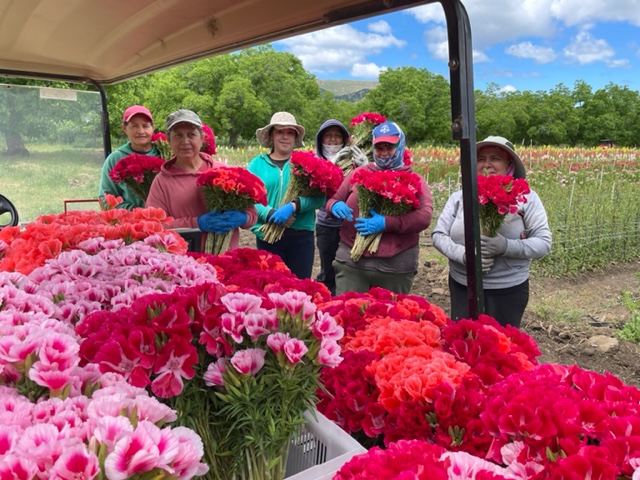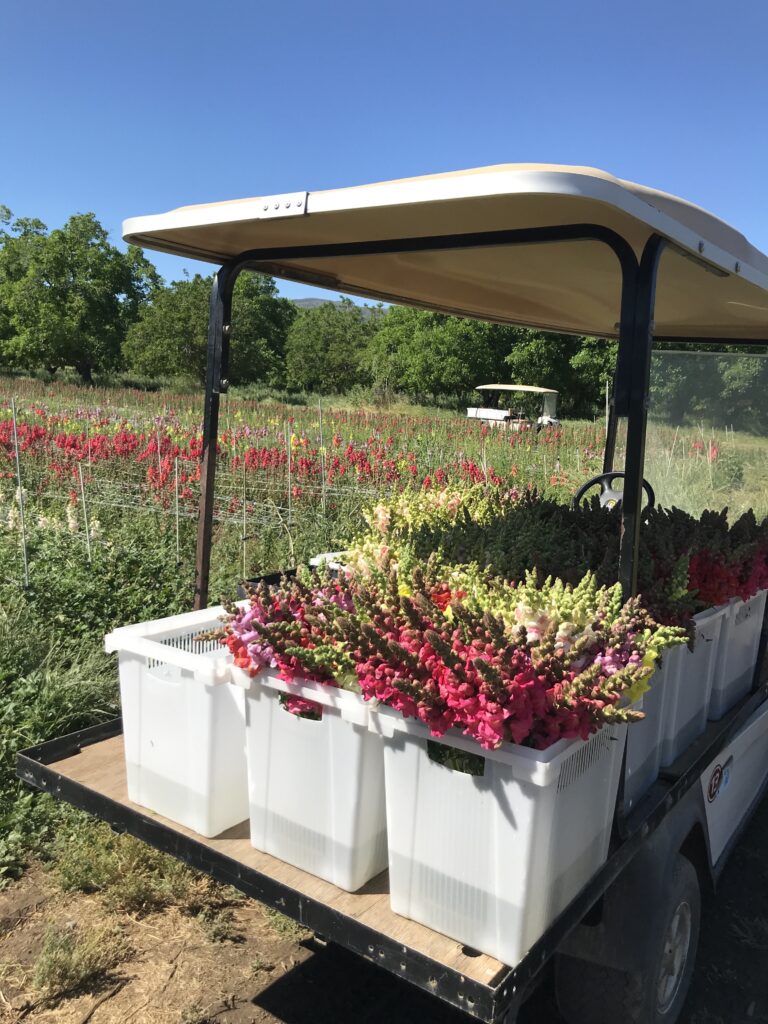
Mother’s Day week has come and gone. It’s different from other weeks in May, or any other week during the year, because of the enormous number of flower orders. In total, the flower team harvested and bunched over 5,500 bouquets last week, about 3,500 mixed and 2,000 single variety. In comparison, the week before, it was 2,900 bouquets, 1,160 mixed. WOW! How’d they do it? What’re the secrets to pulling off this feat?
First, a great team. It’s currently a group of seven headed by Isabel, Hannah, and Dru. They soldiered through strong wind and rising temperatures, to get it all done. To get a head start on the week, they were out picking on Sunday morning despite the rain the day before. During the week, the regulars got help harvesting and bunching from folks who normally work on other harvest teams or in the shop.
Obviously, you need flowers. All the seeds and transplants planted in late October and early November are ready for harvest! You can see in these photos, mostly taken on Friday, the many rows of flowers still had plenty out there, despite lots of picking. The limitation is hours in the day to pick and bunch, not a shortage of flowers. The team made regular trips back to the shop with truckbeds and golf carts packed with full harvest buckets. It seemed like there were godetias everywhere and flowers in every cooler, not just the one specifically designated for flowers!


Then it comes to infrastructure and supplies. Harvesters need gloves, clippers, rubber bands, and LOTS of buckets filled with a few inches of cold water. Buckets might have loose stems or single variety bunches. In the shop, they need more buckets, more rubber bands, paper sleeves, cutters (to even out the stems), and boxes to put buckets in for loading on the truck. Mixed bouquets are assembled in the shop in the afternoon.

To get the flowers onto a delivery truck we need boxes, pallets, and a Rye Muller creation called an “invento” which allows us to get three layers of flowers on the truck with the same footprint as a single pallet. For some of our wholesale customers, we use large floral boxes, which allow us to stack multiple layers of flowers. Moving around all these flowers requires pallet jacks, carts, and rolling racks, and there were lots of lists and labels to keep track of what still need to be harvested, what was done, and what was ready to go on a delivery truck.



The last thing you need are delivery trucks to bring all the flowers to CSA sites, stores, and awesome drivers and farmers market teams, which we have.
This level of flower activity isn’t sustainable every week, but for special occasions, it’s what we do. A big round of applause for the flower crew, and the other hands that helped get everyone their flowers.
The numbers show that people love our flowers, and we hear from happy customers all the time. It’s great to know how much people appreciate our flowers, and not just for their beauty, but also because they’re organic and local. There’s a big difference between how organic and non-organic flowers are grown. Commercial flower production relies heavily on pesticides and chemical fertilizers to get tall, blemish-free blooms, which can harm workers, the environment, pollinators, and customers. Flowers are a very globalized industry and flowers grown abroad are not held to the same environmental and labor protections that we have in the US. Plus local flowers are much fresher, don’t require preservatives, and support local agricultural producers. Whether intentional or not, anyone who gets one of our bouquets is making a statement of support for the type of agriculture that we practice.
On this more normal week, the flower team is back out picking again as usual, making bouquets and saving flowers to dry to make into wreaths and dried bouquets this fall! The work never ends.
Elaine Swiedler, CSA Manager


